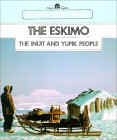Eskimo
Origins: no longer
considered refugees from Ice Age Europe, Eskimos are seen to have a complex history from
Siberia to Greenland
Eskimo Origins in
Siberia: ancestors
of the Aleut and Eskimo arrived in North America from Siberia 6,000 years ago, some
experts say
Arctic Small Tool Tradition to
Paleo-Eskimo: encompassing
the Denbigh Flint culture people of Alaska and Paleo-Eskimo of the Canadian Arctic and
Greenland who spread rapidly across the North 4000 years ago in a path suggested by this map
Aleutian Origin of ASTt: artifacts such as 3000 year old labrets and
miniature carved masks suggest ASTt originated in Aleutians, while others believe it
evolved around Bering Strait and in northeastern
Siberia
Palaeo-Eskimos of Canada: arrived from Alaska ca. 4000 years ago with
microblades, harpoons tipped with tiny stone end
blades, adzes, then
in eastern Canada evolved into Pre-Dorset culture with toggling harpoons
Eskimo Peoples of
Alaska: some 2700
years ago near the Bering Strait, people combined cultural traits from the Arctic Small
Tool tradition (chipped stone tools), southeast Alaska (ground slate tools), and from
Chukotka in Siberia (ceramics), forging Alaska's Eskimo culture
Inuit Migration: map shows Inuit migration from Siberia
across North America to Greenland, and a second map shows their coastal homeland
Origins seen through Genetics:
resources on the
genetic relationships of the ancestors of the Aleut, Eskimo and Chukchi
Eskimo
Culture [ Top ]
Eskimo Culture: similar across 5,000 miles of the Arctic, with toggle
harpoons, fur garments, sleds, more; more on unity
of Eskimo culture
Siberia
Old Bering Sea Hunting
Equipment: harpoon
parts from Diomede Islands in Bering Strait, ca. 2000 BP, and Old Bering Sea
artifacts ca. 2250
BP when the culture originated on the Siberian side of the Bering Strait and the Bering
Sea islands, already equipped for maritime hunting
Ekven burial ground & settlement -
Uelen, Chukotka: this
500 BC to 1000 AD site gives a look at Early Whale Hunter cultures, includes walrus ivory
tools, human burial in a boat, dog burial. The Ekven shamaness burial contained many artifacts including:
· a burial mask
· masks and dance goggles
· ivory
carving imitating metal on shaman's costume
· pottery paddle with carved shaman/bear & circles
Eskimo-type harpoons are known no further west than Chukotka
Ruins of a Whalebone House: at Avan near Provideniya, Chukotka
Alaska & Bering Strait &
Aleutians
Aleut Baidarka or Kayak: from the Commander Islands, west end of the
Aleutians, and more on the kayak and other North Pacific Rim artifacts
Kachemak Bay & Kenai Peninsula
& Kodiak Island Cultures & Artifacts: Ocean Bay II 4500-4000 BP, Arctic Small Tool Industry
4000 BP, Early Kachemak Tradition with open socket harpoon head and Late Kachemak
Tradition 3000-1000 with toggling harpoon
Alaskan Eskimo cultural
artifacts included varied objects:
· Items of walrus ivory including carvings of animals, people; objects
such as counterweights for harpoons and harpoon sockets
· Items of wood including fishing net floats and rattles
· Harpoon
heads & fish hooks carved of ivory or wood
· Fishing decoys and masks carved of wood
Alaskan Eskimo
Slate Tools: blades and knives as well as harpoon tips
and toggling harpoon heads with blades inserted
Eskimo Art & Masks: 20 cultural artifacts from Bering Strait including:
· Carved walrus ivory bear
charm
· Ipiutak
style mask
· Half-man
& half-animal mask
· Shaman's helper mask -
riding a beaver
· Shaman's mask with sun & moon & dog spirits
Eskimo culture in Alaska
with pictures of slush net, fish hook, fish net, whaling, kayak, Punuk period carvings,
harpoon with foreshaft, rope and heads typical of St. Lawrence Island, plus archaeology
and history
Eskimo culture of Alaska's
Bering Strait during the Norton
period some 2000 years ago saw a wealth of new equipment from kayaks, umiaks and float
harpoons to snow goggles, ice creepers, ivory objects and more, the gear identified with
the later Eskimo cultures
Languages of the Yupik and Inuit: a review of the western and eastern Eskimo languages
including links to the Siberian Eskimos
Northern
Alaska Eskimo Baleen Basketry: using
baleen from bowhead and other whales
Canada
Arctic Small Tool Tradition: likely originating in Siberia, people of the ASTt migrated to Alaska, then
across Canada where they were called
· PaleoEskimo
or Pre-Dorset - microblades, stone
point, hearth, then
· followed by Dorset - harpoon heads, points, shaman's equipment
· followed by Thule - whale harpoon, house reconstructions
· and then by modern
Inuit - with lifestyle to match the
climate
Eskimo cultural artifacts in
Canada varied over time including:
· Early
Palaeo-Eskimo artifacts - microblades, cores, harpoons
· Early Palaeo-Eskimo
artifacts - harpoon end blades, sideblades
from Newfoundland
· Late
Palaeo-Eskimo artifacts - bone harpoons, art carved of bone,
ground slate projectile points, microblade knives, soapstone vessels
· Dorset Eskimo artifacts - harpoon end blades and microblades from
Newfoundland, Labrador
Early Paleo-Eskimo Cultures: stone points, remains of dwellings, from the Eastern
Arctic of North America
Canadian Dorset Art: wood and ivory sculpture and masks, and an in-depth look at Paleo-Eskimo & Dorset
cultures with a big gallery of Dorset
art including bears, seals, birds,
humans, more, and another Dorset invention, oil-lamps
Canadian Eskimo Art: with sculptures of bears, more, plus examples of new and ancient Eskimo carvings, and art of the Canadian Inuit
Canadian Inuit Cultures: descriptions of artifacts of Eskimo or Inuit
cultures: Denbigh Flint Complex 4500-2800 BP in Alaska and the Pre-Dorset 4500-2800 BP in
Canada, then Dorset and Thule
Inuit technology: composite
toggling harpoon attributed to the
Alaska Thule people along with the kayak, plus the ulu knife and comb
Harpoons
- Barbed & Toggling: resources on this key cultural element
Pottery:
a cultural element from Jomon-era Japan and the Amur River that reaches the Far North,
becoming part of Eskimo culture
.
